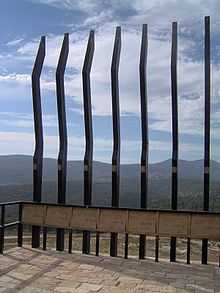Olei Hagardom

Olei Hagardom (Hebrew: "Those hanged in the gallows", עולי הגרדום) refers to members of the pre-state Jewish underground who were tried in British Mandate courts and sentenced to death by hanging, most of them in Acre prison. There were 12 Olei Hagardom.[1]
History
The British Mandate for Palestine was an instrument of government instituted by the League of Nations for the administration of territories formerly under the rule of the Ottoman Empire. British rule lasted from 1917-1948.
During the 1936–1939 Arab revolt, the militant group known as the Irgun embarked on an intensive armed campaign against Arab targets. Later British targets were added also. With the outbreak of World War II, militant actions against the British were halted, but one of the leaders of the group, Avraham Stern, insisted that the fight must go on, leading to a split in the Irgun which led to the formation of a new group, Lehi (also known as the Stern Gang). In 1944, the Irgun, now headed by Menachem Begin rejoined the fight against the British. After the end of World War II, the larger Haganah joined the fight within a union called the Jewish Resistance Movement.
Olei HaGardom refer to the nine Irgun and three Lehi members who were executed during this period. With the exception on Ben Yoseph, all executions within the British Mandate of Palestine were carried out in 1947. They were tried under the Defence Emergency Regulations, enacted in September 1945. These regulations suspended Habeas Corpus and established Military courts. They prescribed the death penalty for various offences, including carrying weapons or ammunition and membership in an organization whose members commit these offenses.[2]
List of Olei Hagardom

Irgun members
- Shlomo Ben Yoseph: The first Oleh Hagardom. He was arrested after an attack on a bus carrying Arab civilians in Safed. He was executed on June 29, 1938.
- Dov Gruner: Arrested while attacking the Palestine Police station in Ramat Gan. He was executed on April 16, 1947.
- Mordechai Alkachai, Yechiel Dresner, Eliezer Kashani: Arrested en route to an attack on British officers on the "Night of the Beatings". They were executed on April 16, 1947.
- Meir Feinstein: Captured after bombing Jerusalem train station. Committed suicide in his jail cell with a hidden grenade on April 21, 1947.
- Yaakov Weiss, Avshalom Haviv, Meir Nakar: Convicted for their roles in the Acre Prison Break. Executed on July 29, 1947.
Lehi members
- Eliyahu Hakim, Eliyahu Bet-Zuri: assassinated Lord Moyne in Cairo. Executed in Cairo on March 22, 1945.
- Moshe Barazani: captured while carrying a grenade and accused of attempting to assassinate Brigadier Davis, the British army commander of Jerusalem. Committed suicide in jail together with Meir Feinstein on April 21, 1947.
Barazani and Feinstein
Moshe Barazani and Meir Feinstein committed suicide in their prison cell with handgrenades smuggled to them in a basket of oranges. The grenades were placed inside hollowed out orange peels.[3] The original plan was to carry the concealed grenades with them as they were taken to the gallows then use them to carry out a suicide attack, but allegedly after they learned that Rabbi Goldman would be present at the time of the execution, the plan was dropped. Instead, Barazani and Feinstein blew themselves up in their jail cell shortly before the execution.
Irgun actions to stop the executions
After Yaakov Weitz, Avshalom Haviv, Meir Nakar were sentenced to death for their role in the Acre Prison Break, Irgun kidnapped two British military policemen, Clifford Martin and Mervyn Paice while they were off duty in Netanya. Irgun announced that hanging its fighters would result in the subsequent hanging of the British soldiers. The death sentences were carried out on July 30, 1947. Clifford Martin and Mervyn Paice were found hanged in Netanya. Their bodies had been booby-trapped with a homemade bomb.
Menachem Begin spoke of the event saying: "it was one of the most bitter moments of my life but the cruel action in Netanya not only saved dozens of Jews from the gallows but also broke the neck of the British occupation, because when the gallows break down, the British rule, which is relied on it, breaks on its own".[citation needed] After this event, there were no more executions of Jewish militants by the British.
Commemoration
Many streets in Israel are named after Olei Hagardom or those who were executed. The Ramat HaHayal neighbourhood in Tel Aviv and the Armon HaNetziv neighbourhood in Jerusalem have streets bearing the name Olei Hagardom or the names of individual fighters.[1] In Ramat Gan, there is an official square and statue honouring Dov Gruner and Olei Hagardom. An official commemoration ceremony takes place on Yom Hazikaron at the memorial in Rishon LeZion, which stands near Olei HaGardom Street.
See also
- List of notable Irgun members
References
| Wikimedia Commons has media related to Olei Hagardom. |
- ↑ 1.0 1.1 Sheleg, Yair (2007-04-07). "The good jailer - Haaretz - Israel News". Haaretz. Retrieved 2013-06-19.
- ↑ Guy Carmi, On the Constitutionality of the Death Penalty in Israel
- ↑ 'The%20good%20jailer%20'&dyn_server=172.20.5.5 The good jailer - Haaretz - Israel News